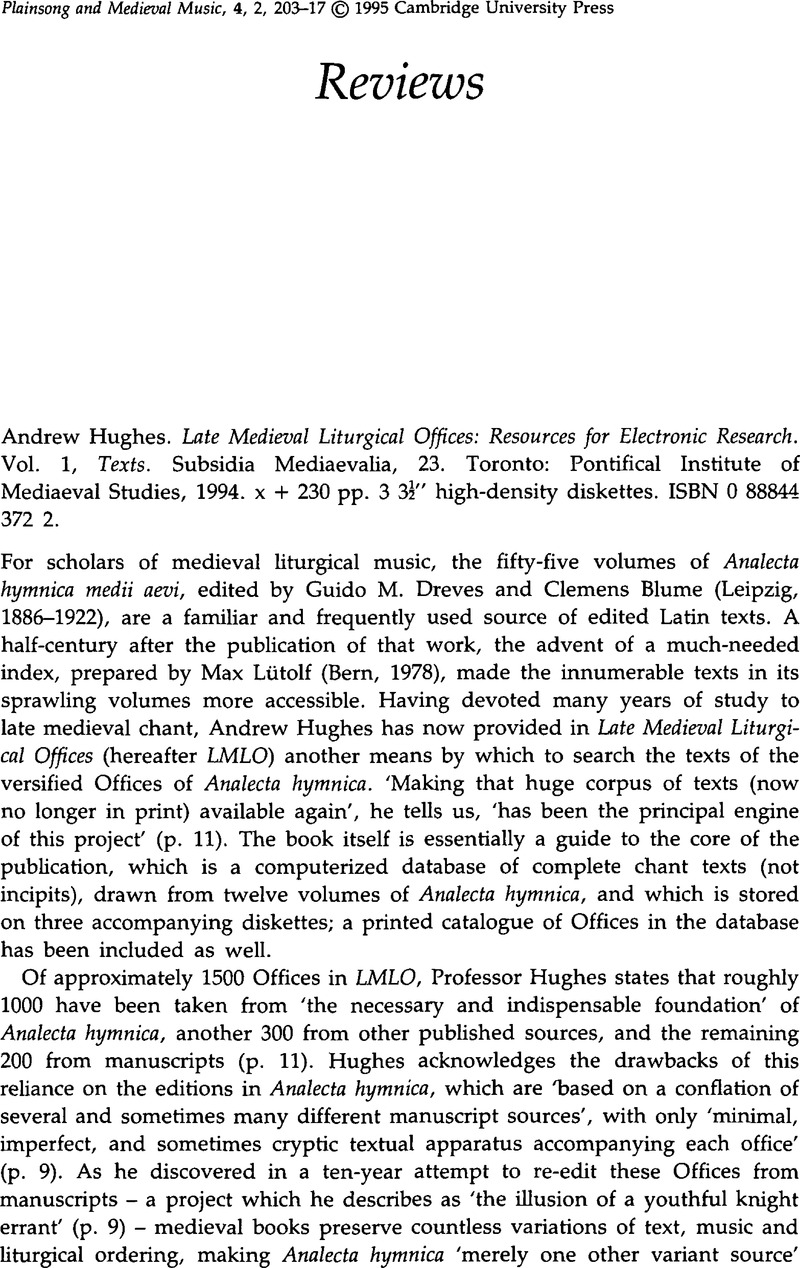No CrossRef data available.
Article contents
Hughes Andrew. Late Medieval Liturgical Offices: Resources for Electronic Research. Vol. 1, Texts. Subsidia Mediaevalia, 23. Toronto: Pontifical Institute of Mediaeval Studies, 1994. x + 230 PP. 3 3½″ high-density diskettes. ISBN 0 88844 372 2.
Published online by Cambridge University Press: 12 September 2008
Abstract

- Type
- Book Review
- Information
- Copyright
- Copyright © Cambridge University Press 1995
References
1 In his other writings, Prof. Hughes himself has underscored the necessity of manuscripts for the study of liturgical chant. See especially his ‘Chants in the Rhymed Office of St Thomas of Canterbury’, Early Music, 16 (1988), 185–201.Google Scholar
2 Hymn texts have not been included in the database (pp. 11, 20–2). Thus scholars who make use of Analecta hymnica when they wish to locate a hymn text for which only an incipit is provided, or of which a stanza other than the first appears in an antiphoner or breviary, will not be helped by LMLO. However, the accuracy of hymn texts in Analecta hymnica has been severely questioned, for example, in Susan Boynton, ‘Recent Research on Latin Hymns’, Plainsong and Medieval Music, 3 (1994), 110.
3 This Adalbertus was the Archbishop of Prague whose feast-day was 23 April. He is not the English missionary to the Netherlands whose relics are housed at the monastery of Egmond, discussed in Marcel, A.Zijlstra, J., ‘The Office of St Adalbert: Carte de visite of a Late Medieval Dutch Abbey’, Plainsong and Medieval Music, 3 (1994), 169–63.Google Scholar
4 My thanks for this observation are due to my colleagues Keith Glaeske and Denise Gallo, the compilers of the index of F-Pn lat. 12044, which is available on the Internet via Gopher from the CANTUS project at The Catholic University of America, Washington, D.C. (gopher://vmsgopher. cua.edu).
5 The antiphon ‘Sestinabos insula’ is identical, after the first word, to the antiphon for Prime in UR71, ‘Sol novus ab insula’. Following it, the antiphon ‘Virginalem adornatum’ differs from the fourth Lauds antiphon in UR71, ‘Muliebrem ad ornatum’, only in the first two words. Finally, the alternative Vespers antiphon ‘Lauda deum deum tuum’ may be found in UR76, also as an alternative Vespers antiphon but beginning ‘Lauda deum tuum’. Whether the errors are scribal or editorial in nature, the user may wish to excise these items from the database or conflate them with their corresponding variants.
6 Chant databases that can be accessed through the Gopher server at the University of Regensburg are said to be ‘placed here at the disposal of colleagues in accordance with the aims of the International Musicological Society Study Group “Cantus Planus,” which promotes cooperation in computer-assisted projects and the exchange of data in electronic form’.




